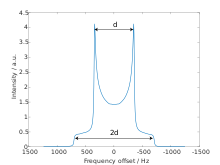Solid-state nuclear magnetic resonance
Solid-state nuclear magnetic resonance (ssNMR) is a spectroscopy technique used to characterize atomic-level structure and dynamics in solid materials.These interactions directly affect the lines shapes of experimental ssNMR spectra which can be seen in powder and dipolar patterns.ssNMR is often combined with magic angle spinning (MAS) to remove anisotropic interactions and improve the sensitivity of the technique.However, in media with no or little mobility (e.g. crystalline powders, glasses, large membrane vesicles, molecular aggregates), anisotropic local fields or interactions have substantial influence on the behaviour of nuclear spins, which results in the line broadening of the NMR spectra.Chemical shielding is a local property of each nuclear site in a molecule or compound, and is proportional to the applied external magnetic field.These induced currents create local magnetic fields that lead to characteristic changes in resonance frequency.[6][7] A similar method to MQMAS is satellite transition magic angle spinning (STMAS) NMR developed in 2000.In presence of a chemical shift anisotropy interaction, each orientation with respect to the magnetic field gives a different resonance frequency.Fitting of the pattern in a static ssNMR experiment gives information about the shielding tensor, which are often described by the isotropic chemical shiftTo achieve the complete averaging of these interactions, the sample needs to be spun at a rate that is at least higher than the largest anisotropy.[9][10] Spinning a powder sample at a slower rate than the largest component of the chemical shift anisotropy results in an incomplete averaging of the interaction, and produces a set of spinning sidebands in addition to the isotropic line, centred at the isotropic chemical shift.It is typically used to enhance the signal of a dilute nuclei with a low gyromagnetic ratio (e.g. 13C, 15N) by magnetization transfer from an abundant nuclei with a high gyromagnetic ratio (e.g. 1H), or as a spectral editing method to get through space information (e.g. directed 15N→13C CP in protein spectroscopy).Spin interactions can be removed (decoupled) to increase the resolution of NMR spectra during the detection, or to extend the lifetime of the nuclear magnetization.The reintroduction of such dipolar coupling reduces the intensity of the NMR signal compared to a reference spectrum where no dephasing pulse is used.Fast MAS and reduction of dipolar interactions by deuteration have made proton ssNMR as versatile as in solution.This includes spectral dispersion in multi-dimensional experiments[27] and structurally valuable restraints and parameters important for studying material dynamics.[29] Magic angle spinning dynamic nuclear polarization (MAS-DNP) is a technique that increases the sensitivity of NMR experiments by several orders of magnitude.[35] Beta-detected nuclear magnetic resonance (β-NMR) is specialized technique that has working principles similar to muon spin spectroscopy.[36] It is used in domains such as chemistry, materials science, condensed matter physics, and biology as a powerful probe.[38] What makes β-NMR different than conventional NMR is firstly, where and when the spin polarization of the nuclei occurs and secondly, how the signal is produced.[36][39] To conduct a β-NMR experiment, optical pumping is performed on a radioactive beam of particles, such as 8Li and 31Mg, to polarize their nuclear spin to nearly one-hundred percent.[36][40] ssNMR spectroscopy serves as an effective analytical tool in biological, organic, and inorganic chemistry due to its close resemblance to liquid-state spectra while providing additional insights into anisotropic interactions.[41] It is used to characterize chemical composition, structure, local motions, kinetics, and thermodynamics, with the special ability to assign the observed behavior to specific sites in a molecule.[46] ssNMR is used to study biomaterials such as bone,[47][48] teeth,[49][50] hair,[51] silk,[52] wood,[53] as well as viruses,[54][55] plants,[56][57] cells,[58][59] and collected biopsies.ssNMR has been successfully used to study metal organic frameworks,[64] solid-state batteries, [65] surfaces of nanoporous materials,[66] and polymers.







nuclear magnetic resonancespectroscopydipolar couplingquadrupolar interactionsj-couplingmagic angle spinninganisotropicbiologymedicineresonance frequencynuclear spinmagnetic fieldnucleuschemical shiftcouplinge.g. chemical shift anisotropyBrownian motionMagnetic dipole-dipole interactionmagnetic dipole momentgyromagnetic ratiogyromagnetic ratiosreduced Planck constantvacuum permeabilitymagic angleQuadrupolesecond rank tensorelectric field gradientZeeman interactionsLegendre polynomialDAS (Double Angle Spinning)chemical bondsParamagneticKnight shiftPake doubletdipolarchemical shift anisotropyCross-polarizationdecoupledNMR crystallographicquality factorDynamic nuclear polarizationklystrongyrotronelectron paramagnetic resonancemuon spin spectroscopychemistrymaterials sciencecondensed matter physicsTRIUMFISOLDEMoscowspin polarizationoptical pumpingradioactiveisotopesin vacuumspin–lattice relaxationparity-violatingbeta-decaysurfacemembrane proteinsamyloidfibrilsprotein tertiary structurevirusesplantsbiopsiespolymorphsX-ray diffractionsolution NMR spectroscopymetal organic frameworkssolid-state batteriesnanoporous materialspolymersBibcodeLesage, AnneDuer, Melinda J.Vibrational (IR)Resonance RamanRotationalRotational–vibrationalVibrationalVibrational circular dichroismNuclear resonance vibrational spectroscopyVibrational spectroscopy of linear moleculesThermal infrared spectroscopyUltraviolet–visibleFluorescenceCold vapour atomicVibronicNear-infraredResonance-enhanced multiphoton ionizationCoherent anti-StokesRaman optical activityLaser-induced breakdownAtomicemissionGlow-discharge opticalabsorptionCavity ring-down spectroscopySaturated absorption spectroscopyEnergy-dispersiveExtended X-ray absorption fine structureMössbauerConversion electronPhotoelectron/photoemissionAngle-resolvedTwo-photonphenomenologicalBeta spectroscopyInelastic neutron scatteringNeutron spin echoTerahertzESR/EPRFerromagnetic resonanceFourier-transform spectroscopyHyperspectral imagingSpectrophotometryTime-stretchTime-resolved spectroscopyVideo spectroscopyAcoustic resonance spectroscopyCircular dichroism spectroscopyDeep-level transient spectroscopyDual-polarization interferometryHadron spectroscopy

